Yesterday, I posted this article about a really cool Pre-Colonial Map of the Philippine Islands, made by a couple high school students (reddit link):
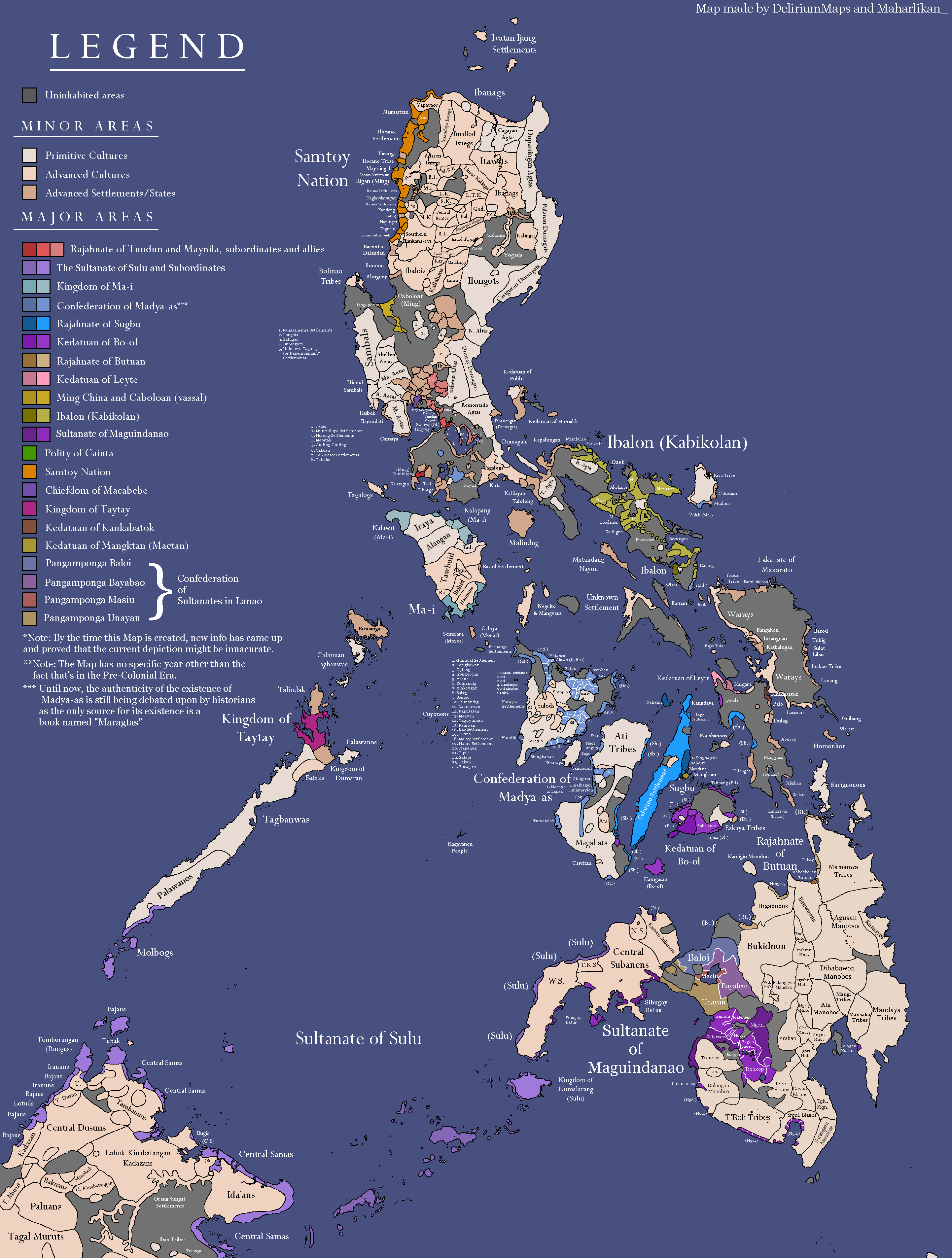
In my post, I mentioned that I collect historical atlases, and that my most common complaint was their lack of pre-colonial coverage. J said he wanted to hear about these atlases, so here you go!
I’ve always loved maps and geography; I had a Usborne children’s atlas when I was growing up, I remember learning about European (and world geography) from board games such as Diplomacy, Civilization, and Axis & Allies.
As I mentioned above, I had learned or noticed somewhere that all of these (along with our education in general) was very much from one euro-centric perspective, so when I was looking at historical atlases, I would always look for the one page on each of ‘pre-colonial Americas’ and ‘pre-colonial Sub-Saharan Africa’, and lament the paucity of information there.
Looking back, I know I’ve been collecting them for at least 20 years now, as I have acute memories of searching used book stores in St. Louis circa 2001-2 for atlases not written in English, so I could try to figure out the subject of each of the maps from context only. I remember them (both historical atlases and non-English atlases) being difficult to find at the time, there might be none or only one in each store, and I might already have that one (or it might be mostly copied from other atlases….more on that later!)[1] The atlases that I’m going to list are the ones currently on my shelf. I know I’ve lost a few along the way, either to water damage or other reasons, but my shelf is still quite overflowing with them.
Here’s the shelf in question:
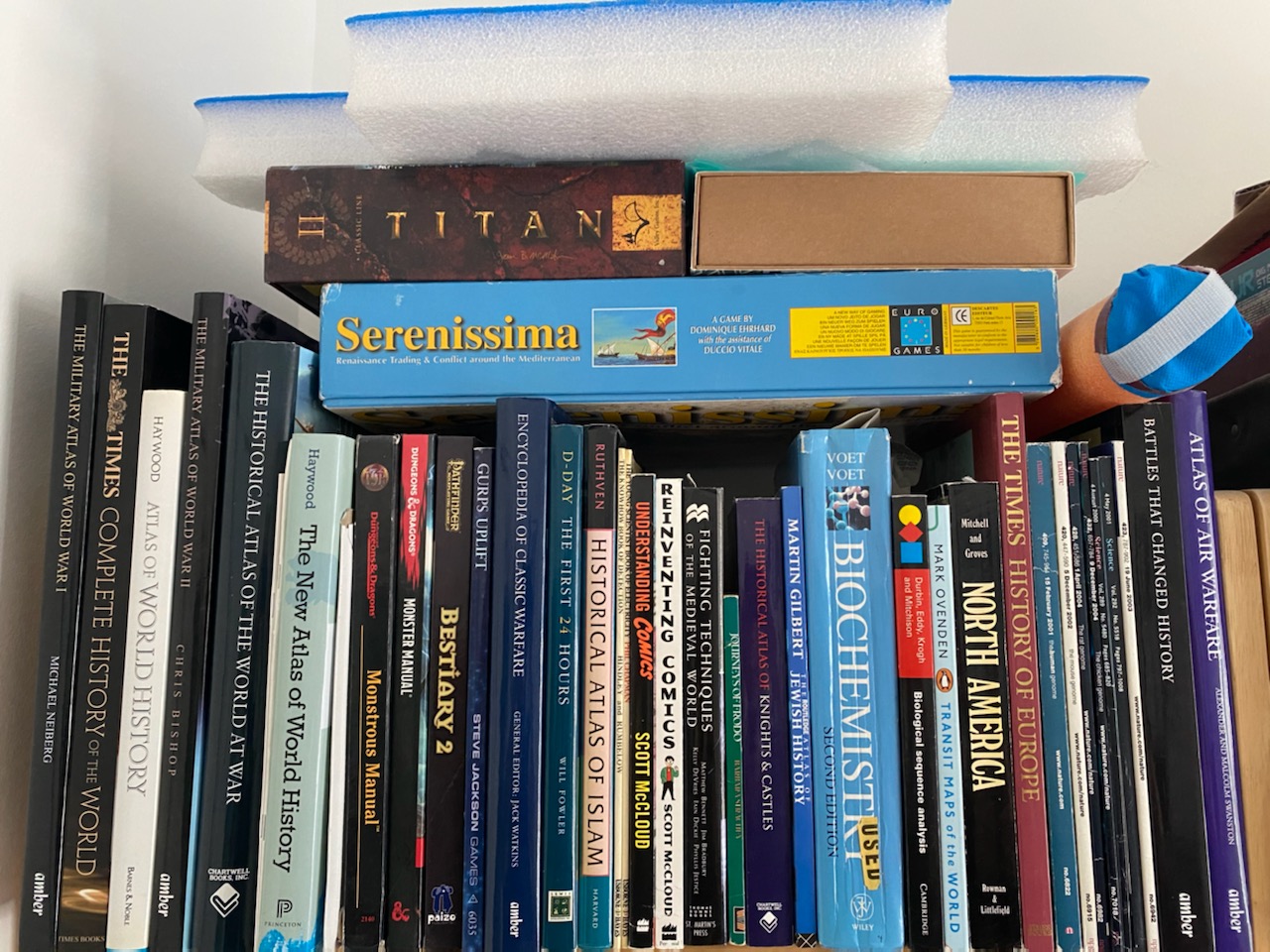
From left to right:
– “The Military Atlas of World War I” & “The Military Atlas of World War II” were bargain bin purchases a few years ago. Comprehensive and detailed, but after a while, reading details about just WWI & WWII gets pretty boring (& dark), so I haven’t read these ones through.
– “The Times Complete History of the World“: Probably the best and most comprehensive single historical atlas on the shelf. I’ve owned various versions of this atlas (or similar) over the years. This particular copy is the 8th edition, 2010, starting c. 5 million years ago with human origins. Great bathroom reading.[2]
– “Atlas of World History“, 1997. Looking at this one, I think I got it used much later than that, or at least I never really read it that much. I’m not sure why. It seems to be as comprehensive as the previous one (starting 4 million BCE, covering world civilizations as much as is generally done), but I think the slightly smaller pages and slightly less colourful maps might have dissuaded me (or perhaps I had already read my fill of others by the time I got this one). Looking at it with fresh eyes right now, it might have a fresh perspective, and better/more comprehensive views on non-European parts of the world, so you might want to take a look yourself.
– “The Historical Atlas of the World at War“, 2009: This is an interesting one, looking at world history (well, mostly the European canon) through the lens of warfare, from “Wars of Settlement and Cities”[3], to the “Iraq War” and “The War on Terror”. If you like red/blue battle diagrams and strategic ‘arrows and dates’ diagrams covering all the battles/wars you’ve heard of (and more), this may be the book for you.
– “The New Atlas of World History, Global events at a glance“, 2011: This is another odd one, with a very rigid structure. Every other two-page layout is a timeline page[4], with horizontal categories such as ‘politics & economy’, ‘religion & philosophy’, ‘science & technology’, and ‘arts & architecture’. The atlas tries to stick as closely as possible to regularly-spaced snapshots, long periods up until the advent of history/agriculture (~6000 BCE), every couple thousand or so years from then up until Bronze Age empires (1300 BCE), then every few hundred years or so from then until the fall of Rome (~500 CE), then every hundred years or so until 1492, then every 50 until the industrial revolution (1763), at which point things start to really accelerate. Looking at this one with fresh eyes, I remember that part of why I chose it was that the format of timeline:world map:timeline:world map forced the author to have something to say about all parts of the world in every snapshot, greatly increasing the coverage of areas outside the standard European canon. Similar to many others, this atlas has more to say about the first half of the 20th Century than the second half, perhaps because social change and a retreat from colonialism are not as interesting to people who like writing about warfare. Still a worthwhile addition.
We then skip over a few random D&D books, and a GURPS supplement to perhaps my favourite sci-fi series ever[5], to come to:
– “Encyclopedia of Classic Warfare: Battles throughout history from Megiddo to Waterloo“, 2011: Another one from the bargain bin ($20), it’s a “fully illustrated history of 170 key battles, campaigns, and wars from the ancient Egyptians to the end of the Napoleonic Wars.” It has pretty good world coverage, perhaps mostly limited by records than anything else. Each of the 170 are described in 1-3 pages of your standard ‘red vs. blue arrows’ maps, with maps to show location and key facts for context.
– “D-Day: The First 24 Hours“, 2003: The largest amphibious operation in history. It’s exactly what it says on the cover. It’s a bit much for me, it’s a lot more detail than I need about this (and it’s tiring to read about WWII), but it might have been where I first learned about Hobart’s Funnies.
– “Historical Atlas of Islam“, 2004 (purchased 2007) and “The Routledge Atlas of Jewish History“, 1993: I’m not going to comment on these, other than to say that some time ago, I thought it important to have both of them on my shelf.
Next, we have a couple of the other Usborne children’s books from my youth, perhaps my two favourites, followed by Scott McCloud’s excellent magnum opus ‘Understanding Comics’ which I would recommend to anyone, and its sequel, where he gives suggestions on how to solve some of the issues he raises in the first book.
– “Fighting Techniques of the Medieval World“, 2006: Just what it sounds like. 500-1500 CE, including a chapter on ‘Command and Control’. Looks like it may share some maps with the ‘Encyclopedia of Classic Warfare’ above, but it’s hard to tell because there are only so many ways to draw a ‘red vs. blue’ map, and the two books are quite different otherwise.
– “Journeys of Frodo“, 1981: Almost more of a travelogue than an atlas, this atlas has dozens of hand-drawn maps showing the day-by-day travels of the various members of the fellowship of the ring. I can’t help but think of ‘DM of the Rings‘, a re-imagining of the story if it were a D&D campaign in a world where no one knew Tolkien.
– “The Historical Atlas of Knights & Castles“, 2010: From ‘The Legacy of Rome’ to somewhere in the 14th-16th centuries, this atlas covers what it says on the cover. As you might expect from the cover, it’s covered from a perspective that one would expect from someone who uses the word ‘Christendom’. There is however a chapter on Samurai, as a nod to the rest of the world beyond the heathens and Mongol hordes.
A couple of books from my mis-spent youth in the biological sciences. Voet & Voet, even though it’s by now decades out of date, is still really comprehensive on a lot of things. I learned Biological Sequence Analysis from one of the authors on the eponymous book, ways of thinking that I probably still use today.
– “Transit Maps of the World“, 2015: A more recent addition to my collection. Includes a bunch of the history of this type of representational map. I’ve always loved looking at transit maps (one of my prize souvenirs from our honeymoon is a puzzle of a commuter rail map of Tokyo), and I’ve wanted to for a while do some mathematical analysis of them. Let me know if that’s something you’d like to see.
– “North America: The Historical Geography of a Changing Continent“, 1990 (Current edition link) I don’t remember where or when I picked up this book, but I’ve kept it through multiple purges because of this one graph:
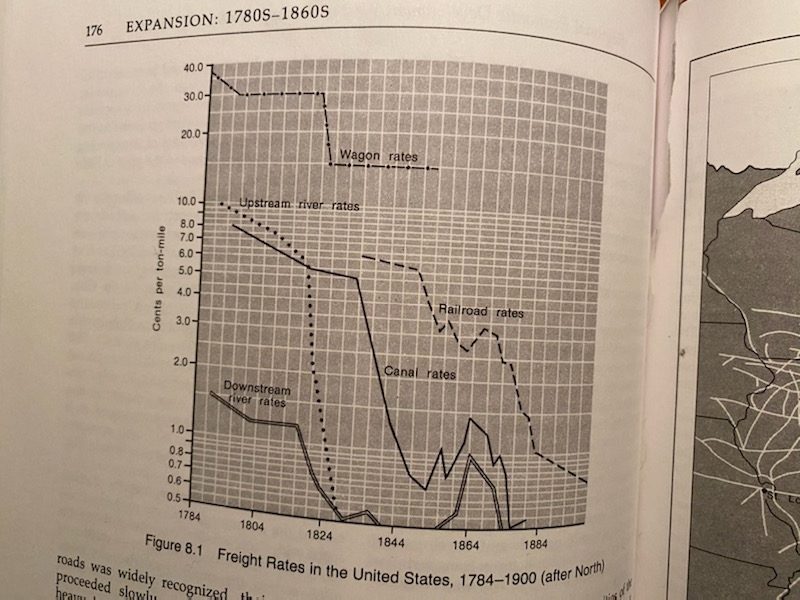
This may not look like much, but this is the type of graph that shows in a very succinct way the economic pressures that shape societal behaviour. You can see the effects of changes in technology, changes in infrastructure, and wars. This is the kind of data that’s super-difficult to assemble, requiring painstaking assembly[6] from centuries-old records and invoices[7], and yet greatly increases our understanding of the pressures that people of the time were feeling when they made their decisions.
– “The Times History of Europe“, 2001: If you look closely, you’ll see that this atlas shares many maps from the ‘Times Atlas of World History’ above, but focuses more on Europe (Natch). Not much else to say. Pretty Euro-centric, and only has four pages for pre-900 BCE Europe, the same number allocated to ‘The Battle of Salamis’. It also has a strange construction, where it shows a two-page snapshot map from the end of a time period, followed by two pages of smaller maps from during that time period. Just odd choices all around.
We then skip over my collection of landmark genomics and protein structure papers[8], and end up with:
– “Battles that Changed History: Key battles that decided the fate of nations“, 2010: From Megiddo, “the first battle to have been recorded in a methodical manner”, through Salamis, Waterloo, all the way to ‘Iraqi Freedom’, this atlas says it shows ’45 of history’s most significant battles’. The battles are covered in detail, with 8-12 pages for each, many more than other surveys of this kind. There are interesting choices made, however. Half of the battles are after 1800, with four from the Napoleonic wars, and similar numbers from each of the U.S. Civil war and the two World Wars. However, there are only four in total, from all of world history from East of the Fertile Crescent, two of which are from the war in Vietnam. In depth summaries, and a bunch of interesting things to say, but very likely playing to a specific audience.
– “Atlas of Air Warfare“, 2009: “With more than 120 detailed aerial combat maps”. Also from teh bargain bin, this is an atlas that really wants to talk about airplanes. There are two pages of discussion of balloons and zeppelins before it gets right into planes. It does discuss the ongoing use of balloons for observation and other purposes along the way, though. Pretty comprehensive, if you’re interested in planes, or the third dimension in general.
Above the books, you see (from top to bottom), my ‘Optimus Prime’ wall hanging, the classic game ‘Titan‘, recently reprinted, and ‘Serenissima‘[9], a renaissance trading and conflict simulation that I bought because I was sad that Age of Renaissance was out of print. The strangely capped pool noodle to the left is from my ‘Nerf gun wedding’, and is my rendition of a comically large Nerf dart.
There is also one other that didn’t make it onto my ‘oversized’ shelf:
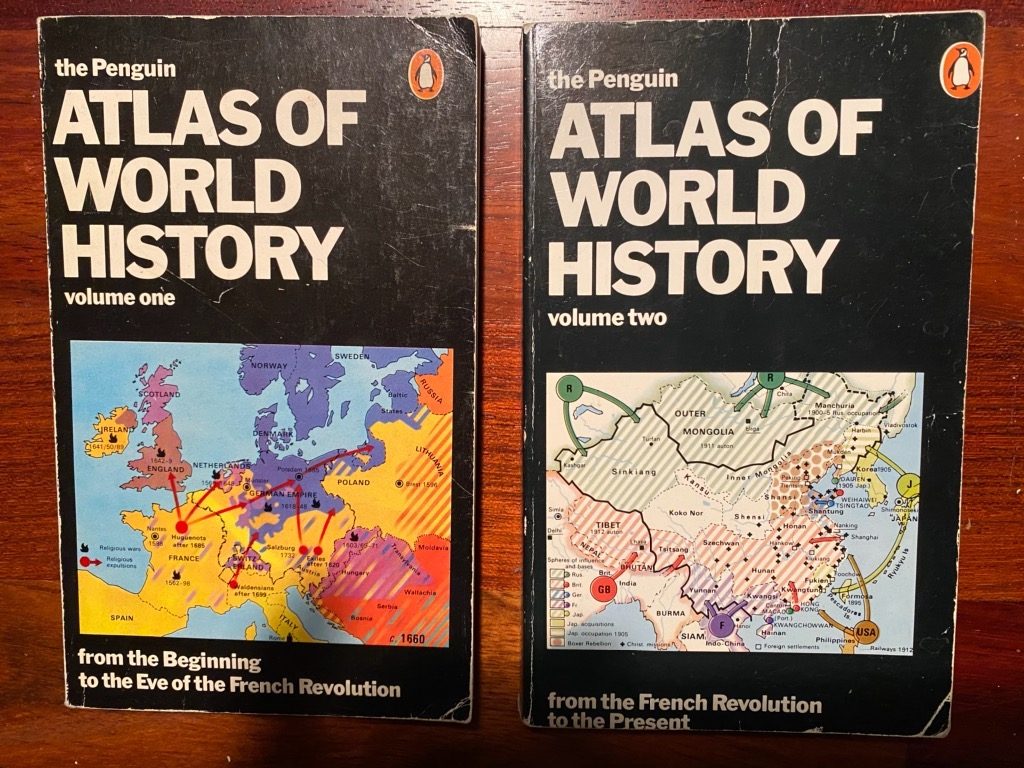
This atlas (in two volumes) is another interesting oddity. It’s stunningly comprehensive for its small size, seemingly meant to be used as a reference book not just for maps but for much of history by someone who has learned much or most of it in the past, and wants to see how it all fits together.
I’ve always loved its relentless abbreviations:

Here you can see them used, even when it’s not necessary to save space:
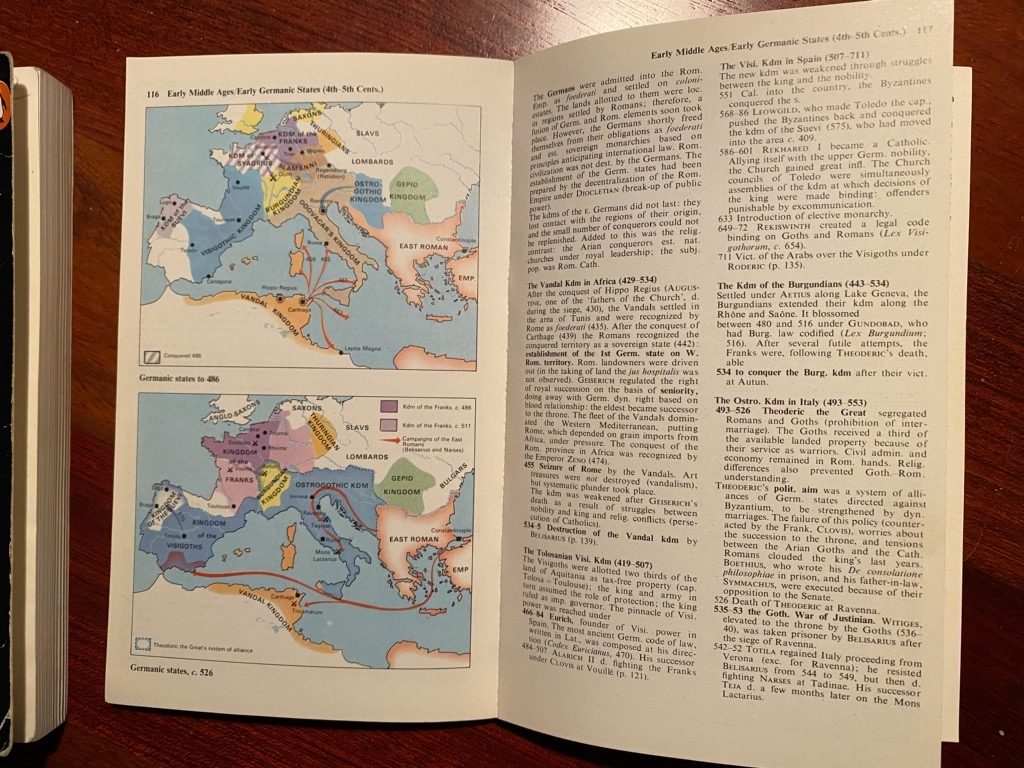
…such as the ‘Vandal Kdm’, or the ‘Ostro.’ or ‘Visi.’ (goths), all abbreviations that would be relatively easily decodeable for someone steeped in the Western canon, but perhaps impenetrable for the average reader.
And that’s all for today! Let me know if you want a more in-depth review of one of these, or anything else you see here. This has been a super-fun trip down memory lane for me. I’m going to go peruse an old atlas now.
[1] You may also be interested in online historical atlases. My favourite is the “Historical Atlas of the 20th Century” by Matthew White, who is working on his second associated book. Please note that a lot of human history is not kind, and he does a lot of research into atrocitology, to try to help understand why humans do the things we do to each other.
[2] When I was avidly reading them, I used to read them in the bathroom. They’re perfect for that, as each two-page spread is self-contained, so you can read it in any number of manageable chunks, depending on how much time you have.
[3] Feels like Civilization all over again, especially the ‘wars of settlement’…
[4] Vaguely reminiscent of perhaps the most famous visual history timeline, “Adams’ Synchronological Chart or Map of History“, which perhaps to continue to best express the classical British conception of history that continues to colour many peoples’ perceptions, whether or not they know it.
[5] David Brin has such wonderful ideas. I recommend starting with his short story ‘Aficionado‘.
[6] For me, this is similar to how when you look at a map in a historical atlas, and think about every dot on the map, and how each of them could easily have been someone’s doctoral thesis or life’s work.
[7] Obligatory. Note that the famous tablet seems to have been only one of many.
[8] Let me know if you want me to talk about these. I’ve been meaning to for a while, but it’s been like 20 years now.
[9] Note that there’s now a second edition. I’ve only ever really played my copy once, and I can’t give a useful review.